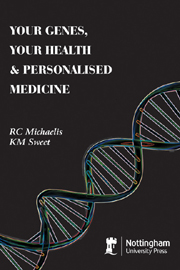Book contents
- Frontmatter
- Contents
- INTRODUCTION
- 1 UNDERSTANDING THE MEANS BY WHICH OUR GENES INFLUENCE OUR HEALTH
- 2 THE MECHANISM WHEREBY A GENE MAKES ITS PROTEIN
- 3 UNDERSTANDING THE PRINCIPLES OF INHERITANCE
- 4 USING YOUR FAMILY HISTORY INFORMATION TO PREDICT YOUR RISK FOR SPECIFIC DISEASES
- 5 USING GENETIC TESTING TO MAINTAIN YOUR HEALTH AND PERSONALISE YOUR MEDICAL CARE, NOW AND IN THE FUTURE
- 6 MAKING THE DECISION WHETHER OR NOT TO HAVE GENETIC TESTING, AND INTERPRETING THE RESULTS OF TESTS YOU CHOOSE TO HAVE PERFORMED
- 7 NUTRIGENOMICS AND EPIGENETICS: THE EFFECTS OUR DIET, ENVIRONMENT AND LIFESTYLE HAVE ON OUR GENES AND PROTEINS
- EPILOGUE AND USEFUL INTERNET RESOURCES
- INDEX
4 - USING YOUR FAMILY HISTORY INFORMATION TO PREDICT YOUR RISK FOR SPECIFIC DISEASES
- Frontmatter
- Contents
- INTRODUCTION
- 1 UNDERSTANDING THE MEANS BY WHICH OUR GENES INFLUENCE OUR HEALTH
- 2 THE MECHANISM WHEREBY A GENE MAKES ITS PROTEIN
- 3 UNDERSTANDING THE PRINCIPLES OF INHERITANCE
- 4 USING YOUR FAMILY HISTORY INFORMATION TO PREDICT YOUR RISK FOR SPECIFIC DISEASES
- 5 USING GENETIC TESTING TO MAINTAIN YOUR HEALTH AND PERSONALISE YOUR MEDICAL CARE, NOW AND IN THE FUTURE
- 6 MAKING THE DECISION WHETHER OR NOT TO HAVE GENETIC TESTING, AND INTERPRETING THE RESULTS OF TESTS YOU CHOOSE TO HAVE PERFORMED
- 7 NUTRIGENOMICS AND EPIGENETICS: THE EFFECTS OUR DIET, ENVIRONMENT AND LIFESTYLE HAVE ON OUR GENES AND PROTEINS
- EPILOGUE AND USEFUL INTERNET RESOURCES
- INDEX
Summary
Your Family History May Provide More Information Than You Think
Although genetic and genomic testing will soon become an important tool to help you learn more about your risk for disease and what you can do to improve your health, we are only beginning to understand how to make sense of the enormous amount of information that is generated from these powerful new technologies. One thing you should keep in mind, however, is that you have a valuable tool that is already available to you, that provides information that is fairly easy to understand, and that can tell you quite a lot about your risk for certain diseases. This tool is your family medical history. Whether you are considering single-gene diseases such as cystic fibrosis or multifactorial diseases such as diabetes or heart disease, your family history can help you learn more about your risk. In fact, even in this new era of whole-genome sequencing and genome-wide association studies, your family history remains the single least expensive and most effective means by which you can estimate your risk for the disorders for which you have the greatest genetic risk.
In order for you to be sure you include all the relevant information in your family history, you should include not only the diseases that have affected your family members, but also as much information as you can about your relatives' dietary, environmental, lifestyle, behavioral and cultural factors.
- Type
- Chapter
- Information
- Your Genes, Your Health and Personalised Medicine , pp. 61 - 86Publisher: Nottingham University PressPrint publication year: 2011



